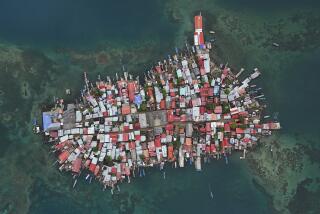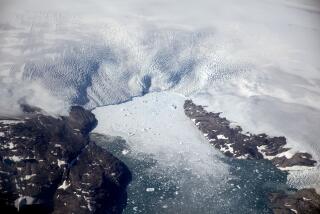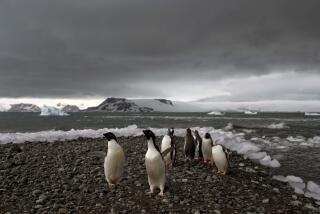Earthwatch: A Diary of the Planet
- Share via
Tsunami Threat
Scientists from University College London issued warnings that the flank of a volcanic island in the eastern Atlantic is at risk of collapsing and generating a wave up to 160 feet high that could swamp coastlines in the Caribbean and Florida. Simon Day of the college’s Hazard Research Center wrote in New Scientist that a huge chunk of La Palma, the most volcanically active island in the Canaries, is now unstable. “If the flank of the volcano slides into the ocean, the mass of moving rock will push the water in front of it, creating a tsunami wave far larger than any seen in history,” said Day. “The wave would then spread out across the Atlantic at the speed of a jet airliner until it strikes coastal areas all around the North Atlantic.” Day’s research found that the volcano’s vents were configured in the shape of a three-pointed star, whose western flank--a mass of about 500 billion tons of rock--is gradually becoming detached as volcanic activity forces magma to the surface.
Eruptions
At least 4,000 residents of Papua New Guinea’s island of New Britain were forced to evacuate their homes following a moderate eruption of Mt. Ulawun volcano.
Mexico’s Popocatepetl volcano sent a 4-mile-high column of ash soaring into the sky southeast of Mexico City in its most powerful eruption this year.
Earthquakes
The most powerful earthquake to strike Africa’s southern Rift Valley since 1910 cracked buildings 60 miles from the epicenter on the shore of Lake Tanganyika.
Strong quakes that rocked southern Japan’s Amamioshima Island forced the evacuation of residents after the shaking unleashed landslides.
Earth movements were also felt in northern Japan, Russia’s Sakhalin Island, Taiwan, western Turkey, Trinidad and southern Mexico.
New Iceberg
Iceberg B-20, estimated to be 10 times the size of Manhattan, has broken loose from Antarctica’s Ross Ice Shelf. Satellites operated by the U.S. Defense Meteorological Agency first detected the new iceberg, which is 30 miles long by 11.4 miles wide and floating near the part of Antarctica that is closest to Australia and New Zealand. It is far from any main shipping lanes. Some scientists have theorized that an increase in the frequency of ice separation in the Antarctic has been triggered by global warming.
Tropical Cyclones
Slowly moving Hurricane Keith caused extensive damage across much of Belize and was responsible for at least 10 deaths in Nicaragua, where most of the victims were swept away by swollen rivers. The storm later regained strength and struck northeast Mexico.
Tropical storm Olivia passed over the open waters of the Pacific off western Mexico.
More to Read
Sign up for Essential California
The most important California stories and recommendations in your inbox every morning.
You may occasionally receive promotional content from the Los Angeles Times.









